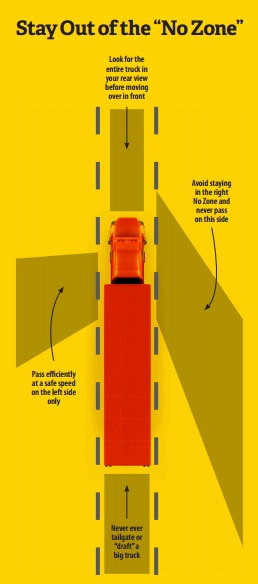Driving a commercial truck professionally requires a great deal of skill and responsibility. As the backbone of our economy, it’s no doubt that truck drivers spend long hours on the road and under tight schedules. While deadlines are important, the safety of truck drivers is more important – not just for their well-being but because their safety impacts other motorists on the road. Below are the safety tips every truck and bus driver needs to know to protect themselves and others on the road.
1. Practice Defensive Driving
The best way to protect yourself and others while on the road is through defensive driving. When you can anticipate a possibly unsafe situation, it’s easier to avoid it and steer clear of the danger ahead. Here are some tips to follow:

- Travel slowly. Always take the corners and exit/entrance ramps very slowly. The posted speed limit is intended for regular-size cars, not for big rigs. Additionally, you should never go above second gear in a parking lot.
- Always signal. Remember that signaling before changing lanes or turning is required by law. Use the “Take 10” rule, which is to turn on your signal for three seconds while checking mirrors and take seven seconds to change lanes.
- Watch your blind spots. According to the NHTSA, over 840,000 accidents per year are directly due to drivers changing lanes. Before starting your trip, adjust your mirrors. Know the “no-zone” blind spots and exercise caution before turning or changing lanes.
- Maintain space cushion. Since large trucks require more stopping time due to their load weight and vehicle size, keep a safe distance of seven to eight seconds between you and the vehicle in front of you.
- Scan ahead. Pay attention to what’s going on a quarter of a mile or more ahead of you. By being aware and practicing situational awareness, you can prevent accidents altogether or, at the very least, decrease the impact if an accident does occur.
- Pay attention to signs and directions. Road signs help us navigate lawfully and safely. They play a significant role for every driver, so it’s essential to regularly check and pay attention to them.
- Avoid distractions. Distracted driving is one of the greatest threats to your safety and the safety of others on the road. Pay attention to everything and avoid using your cell phone at all times.
2. Plan Your Trip
Before heading out onto the road, plan your route with care. Conduct some research to stay up to date on road conditions, weather, traffic patterns, constructions, and road laws that vary by state. Investing in a trucker’s GPS is recommended to help alleviate stress on the road, especially when traveling to unfamiliar places. This gadget can provide vital information such as which exit to take, the distance before an exit, traffic reports, and real-time weather and road conditions.
3. Pre & Post Trip Inspection

A comprehensive pre-trip and post-trip inspection are essential for spotting defects before your big rig becomes a threat to your safety. Not only can it help ensure your fleet of trucks are safe before you start driving, but inspections are required at least once daily during work hours by the DOT. During your inspection, pay close attention to your braking system, steering system, fifth wheel assembly, lights, and tires.
4. Prepare for Dangerous Road Conditions
Road conditions are constantly changing and can be a danger to all drivers. Learn how to drive and navigate through some of these most common and dangerous driving conditions:
- Icy roads
- Snow
- Rain
- Rog
- Road construction
- Accidents
- Disabled vehicles
- Animal on the road
5. Invest in a Dash Cam
To protect yourself from unjust accusations, increased insurance costs, and potential termination by your employer, purchase a dash cam. Determining who is at fault in an accident or figuring out what happened during the accident gets murky. Luckily, dash cams can remove the guesswork of what actually happened and can protect you as a truck driver both legally and monetarily.
6. Perform Regular Truck Maintenance
On-time deliveries are key to driving a successful trucking business. While there are factors out of everyone’s control that can cause delays, you can take responsibility for the one factor you can control, your fleet. Keeping a regular preventative maintenance schedule is essential for the following:
- Meeting DOT regulations
- Avoiding costly repairs
- Increases the lifespan of your truck
- Safety for all
7. Rest and Take Your Breaks

While meeting deadlines is important, it’s crucial to meet rest and break requirements. Driver fatigue is one of the leading causes of accidents in the trucking industry. Under Hours of Service (HOS) regulations, all commercial truck drivers are required to take certain breaks before they can continue driving. Getting enough rest can help you avoid driver’s knee and ensures that you make it home safely.
Customized Your Truck Insurance With AIS
AIS Insurance has been providing affordable commercial insurance coverage for over 20 years. We work with “A” rated insurance companies to get you the lowest rates on your commercial auto or truck insurance. Speak with one of our Commercial Insurance Specialists today at (866) 570-7335 for a quick and easy free quote and see how much you can save.
The information in this article is obtained from various sources and offered for educational purposes only. Furthermore, it should not replace the advice of a qualified professional. The definitions, terms, and coverage in a given policy may differ from those suggested here. No warranty or appropriateness for a specific purpose is expressed or implied.


